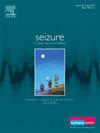Explosive onset focal epilepsies without cortical malformation: A review of a pediatric cohort with pathogenic variations in the GATOR1 complex (DEPDC5, NPRL3 and NPRL2)
IF 2.7
3区 医学
Q2 CLINICAL NEUROLOGY
引用次数: 0
Abstract
GATOR1 complex genes (DEPDC5, NPRL2, NPRL3) are associated with focal epilepsies, often without cortical malformations or intellectual disabilities. Our study focused on 10 children, with GATOR1 pathogenic variation and negative MRIs, all experiencing focal epilepsy onset between ages 1 and 7 years. Three were initially misdiagnosed with immune encephalitis, with seizure frequencies ranging from 2 per week to 40 per day. The seizures were monofocal and stereotyped in the same child. No recurrent brain localization was found in EEG, clinical data, or MRI. After achieving early developmental milestones, some patients developed cognitive or psychiatric challenges during active seizures. Over 1 to 14 years, three experienced recurrent status epilepticus, triggered by infections or medication changes. Currently, two patients are seizure-free on antiepileptic medications, while six continue to have frequent seizures. Notably, only half showed concordance between EEG and PET scan anomalies. Pathogenic variations included five in DEPDC5, four in NPRL3, and one in NPRL2, with six inherited from parents 3 of them being unaffected. The timeline for genetic analysis requests has significantly shortened over time. In cases of pharmacoresistant monofocal epilepsy with normal MRIs, in children with normal development—especially with a family history—testing for GATOR1 variations should be prioritized.
无皮质畸形的爆发性局灶性癫痫:GATOR1复合物(DEPDC5, NPRL3和NPRL2)致病性变异的儿童队列回顾
GATOR1 复合基因(DEPDC5、NPRL2、NPRL3)与局灶性癫痫有关,但通常没有皮质畸形或智力障碍。我们的研究集中于 10 名儿童,他们都有 GATOR1 致病变异,磁共振成像呈阴性。其中三人最初被误诊为免疫性脑炎,癫痫发作频率从每周 2 次到每天 40 次不等。同一患儿的癫痫发作均为单灶性和刻板性。脑电图、临床数据或核磁共振成像均未发现复发性脑定位。在达到早期发育里程碑后,一些患者在活跃的癫痫发作期间出现了认知或精神方面的问题。在 1 至 14 年的时间里,有 3 名患者因感染或换药而反复出现癫痫状态。目前,两名患者服用抗癫痫药物后癫痫不再发作,但仍有六名患者癫痫频繁发作。值得注意的是,只有半数患者的脑电图和 PET 扫描异常表现一致。致病变异包括 DEPDC5 中的 5 个变异、NPRL3 中的 4 个变异和 NPRL2 中的 1 个变异,其中 6 个遗传自父母,3 个未受影响。随着时间的推移,基因分析申请的时限已大大缩短。在核磁共振成像正常的抗药性单灶癫痫病例中,对于发育正常的儿童,尤其是有家族史的儿童,应优先检测GATOR1变异。
本文章由计算机程序翻译,如有差异,请以英文原文为准。
求助全文
约1分钟内获得全文
求助全文
来源期刊

Seizure-European Journal of Epilepsy
医学-临床神经学
CiteScore
5.60
自引率
6.70%
发文量
231
审稿时长
34 days
期刊介绍:
Seizure - European Journal of Epilepsy is an international journal owned by Epilepsy Action (the largest member led epilepsy organisation in the UK). It provides a forum for papers on all topics related to epilepsy and seizure disorders.
 求助内容:
求助内容: 应助结果提醒方式:
应助结果提醒方式:


